-


 Welcome To
Welcome To
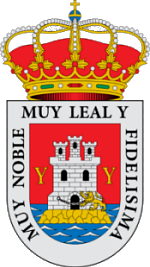 Yecla
Yecla

 Welcome To
Welcome To
 Yecla
Yecla

 Welcome To
Welcome To
 Yecla
Yecla

 Welcome To
Welcome To
 Yecla
Yecla

 Welcome To
Welcome To
 Yecla
Yecla


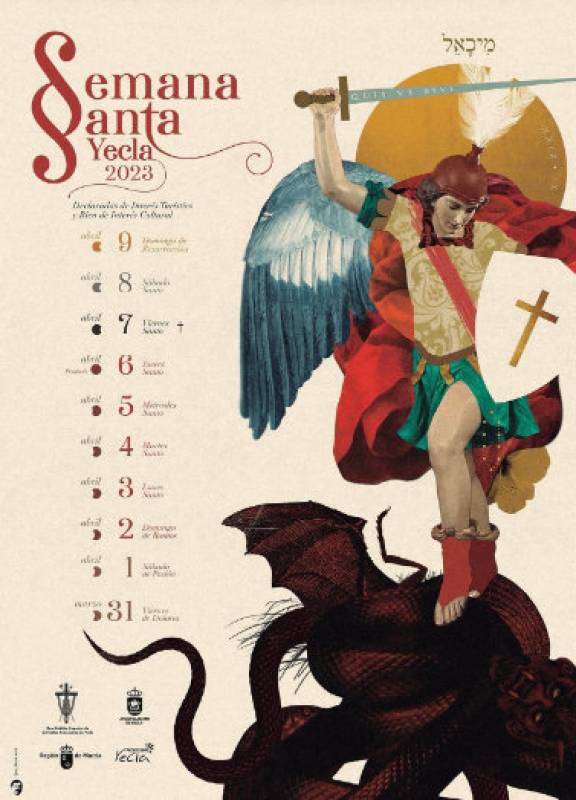 As in many other parts of the Region of Murcia Semana Santa is an important week in the calendar of Yecla, and a number of impressive processions are held featuring its religious and artistic heritage. These are organized by the “Cofradías” (or brotherhoods) who undertake the religious parades of penitence, and have been declared as being of regional tourist interest.
As in many other parts of the Region of Murcia Semana Santa is an important week in the calendar of Yecla, and a number of impressive processions are held featuring its religious and artistic heritage. These are organized by the “Cofradías” (or brotherhoods) who undertake the religious parades of penitence, and have been declared as being of regional tourist interest.
Yecla has an excellent Semana Santa museum in an atmospheric church, which is well worth visiting.
The Semana Santa religious celebrations in Yecla date back to the 16th century and include the traditional "Sermones de Cuaresma" (Sermons of Lent). The first records regarding Cofradias in Yecla relate to the Cofradía de la Sangre de Jesús (The Blood of Jesus), which was linked to the penitence and support of the preaching of San Vicente Ferrer and the Dominican monks.
The next to appear was the Cofradia of the Hermandad de la Cruz (The Brotherhood of the Cross) or of the Vera Cruz, linked to the Franciscans who in that period founded a monastery in Yecla. There is also the Cofradía de Nuestra Señora de la Soledad (Our Lady of Solitude), which included members from the nobility and rich families, as is the case in many other localities throughout Spain. The processions featuring penitents who covered their faces and wore tunics in a format recognisable today began in the seventeenth century.
The most popular procession in the modern Semana Santa of Yecla is on Palm Sunday (Domingo de Ramos) and is known as the Procesión de las Palmas (Procession of the Palms) or "La Burrica" (the little donkey), because it includes a little donkey and is accompanied by a multitude of children and adults carrying palm leaves and olive branches.
But the most picturesque is the Procesión de los Farolicos del Martes Santo, (Procession of the small lights on Holy Tuesday, a farolica being a small lantern) which is for children accompanying the tableau of Christ in a reclined position while carrying their lanterns.
The event which takes place on Jueves Santo (Maundy Thursday) in Yecla is also popular procession among visitors, featuring 17 Pasos or carved figures in the procession known as the Procesión de la Pasión del Señor (Procesión of the Passion of our Lord). More than 3,000 people take part in this procession full of light, music, flowers, art and devotion.
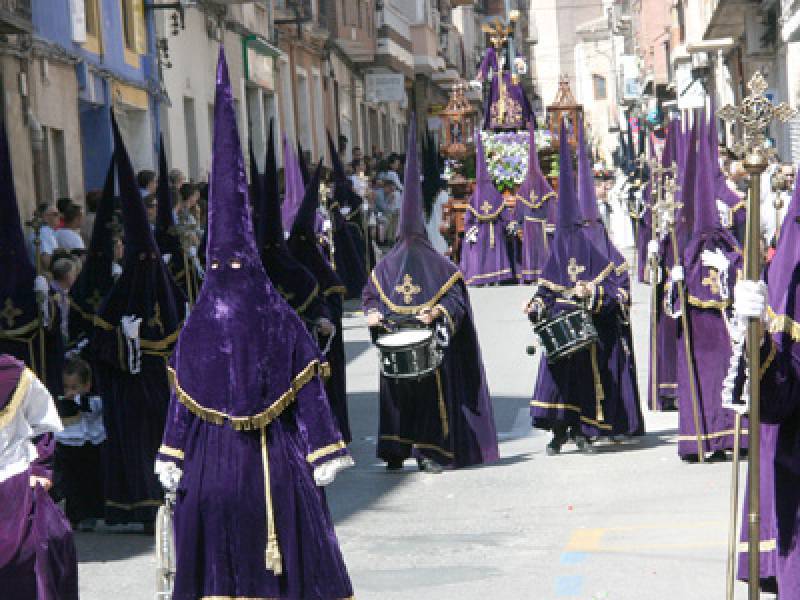 The Procesión del Silencio (Silent procession), takes place at midnight, when all the lights are turned off, and parades through the centre of the town, with only the sounds of saetas, a type of hymn sung by a lone voice, the "Saetas del Silencio" and the prayers of the participants in the Vía Crucis. This is always an atmospheric occasion, charged with emotion as the penitents mourn the betrayal of Christ.
The Procesión del Silencio (Silent procession), takes place at midnight, when all the lights are turned off, and parades through the centre of the town, with only the sounds of saetas, a type of hymn sung by a lone voice, the "Saetas del Silencio" and the prayers of the participants in the Vía Crucis. This is always an atmospheric occasion, charged with emotion as the penitents mourn the betrayal of Christ.
The "Enterramiento de Cristo" (the burial of Christ) on Good Friday also features 17 pasos. It starts at sunset and is one of the most emotional occasions of Semana Santa for the faithful. At midnight, the Virgen de la Soledad is accompanied to join the “Procesión de la Soledad” (procession of solitude) whilst the residents sing the moving "Stabat Mater Dolorosa". The night ends with “La Plática de Despedida" o "Sermón de la Soledad” (Sermon of solitude).
The most important religious sculptures in Yecla are the Virgen de las Angustias (BIC) created by Francisco Salzillo in 1764 and the statue of Santísimo Cristo de la Adoración de la Cruz by José Esteve Bonet (1800).
The program for Semana Santa 2023 in Yecla includes the following:
(Note: images do not correspond to specific days)
Friday March 31, Viernes de Dolores (Friday of Sorrows)
22.00: Procesión de las Siete Palabras de Jesús en la Cruz (Procession of the 7 Words of Jesus on the cross) starting at the Iglesia de San Nicolás.
Route: Calle San Nicolás, Calle Algezares, Calle Padre Lasalde, Calle San Isidro, Calle Mediodía, Calle San Isidro, Calle Cerro, Calle Cuevas del Saliente, Calle Olivo, Calle Corredera, Calle Forte, Calle Martínez Corbalán, Plaza de la Purísima, concluding at the Basílica de La Purísma.
2 Pasos:
1. Nuestra Señora del Dulce Nombre (José Casanova, 1943)
2. Santísimo Cristo de la Misericordia (José Lozano Roca, 1942)
Saturday April 1, Sábado de Pasión
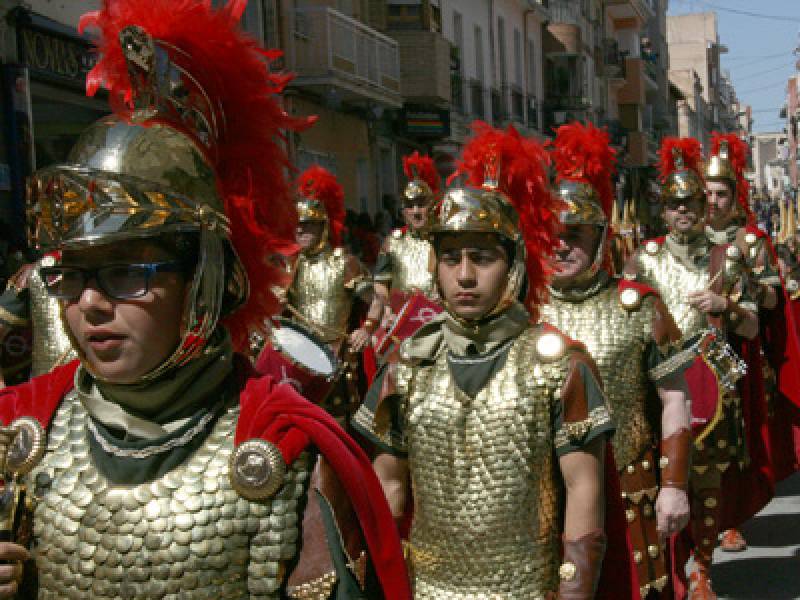 21.00: Procesión de la Sangre y del Perdón (Procession of the Blood and Apology) starting from from the Iglesia de San José Obrero.
21.00: Procesión de la Sangre y del Perdón (Procession of the Blood and Apology) starting from from the Iglesia de San José Obrero.
Route: Calle Arcipreste Esteban Díaz, Calle Paco Corbalán, Calle Maestro mora, Calle Francisco Castaño, Calle San Ramón, Calle Cura Ibáñez and returning to Calle Arcipreste Esteban Díaz and the Iglesia de San José Obrero.
Paso:
- Santísimo Cristo de la Sangre y el Perdón (Anonymous, decade 1910-20)
Sunday April 2, Domingo de Ramos (Palm Sunday)
11.00: Procesión de las Palmas starting at the Iglesia Vieja.
Route: Parque de La Constitución, Calle San Francisco, Calle San Antonio, Calle Numancia, Plaza de La Purísima and the Basílica de La Purísma.
Paso:
- Entrada triunfal de Jesús en Jerusalén (Fernando Ortuño Alburquerque)
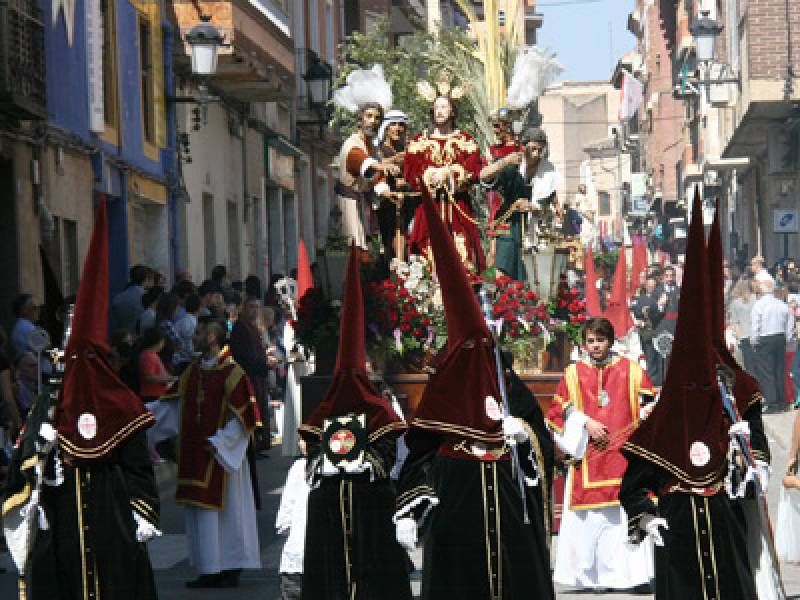 Monday April 3, Lunes Santo (Holy Monday)
Monday April 3, Lunes Santo (Holy Monday)
22.00: Procesión Penitencial del Rosario (Procession of penitence) from the Iglesia del Niño Jesús.
Route: Calle Juan Ortuño, Calle Pizarro, Calle Niño Jesús, Calle Santa Bárbara, Calle Madrid, Calle Ramblizo, Calle Bailen, Calle Algeciras, Calle Tetuán, Calle Castillo, Calle Filipinas, Calle Blas Ibáñez, Calle Epifanio Ibáñez, Calle Quevedo, Calle Niño Jesús, Calle Arco del Niño a la Iglesia del Niño Jesús.
2 Pasos:
1. Santísimo Cristo de la Salud (anonymous, 17th/18th century)
2. María Santísima Dolorosa (José María Ponsoda y Bravo, 1950)
Tuesday April 4, Martes Santo (Easter Tuesday)
21.00: Procesión de los Farolicos (Procession of the lanterns) from the Iglesia Vieja
Route: Parque de la Constitución, Calle San Francisco, Calle San Antonio, Calle Numancia, Calle España, Plaza de La Purísima to the Basílica de La Purísima.
Paso:
1. Santísimo Cristo Yacente (Francisco Teruel Francés, 1945)
Thursday April 6, Jueves Santo (Maundy Thursday)
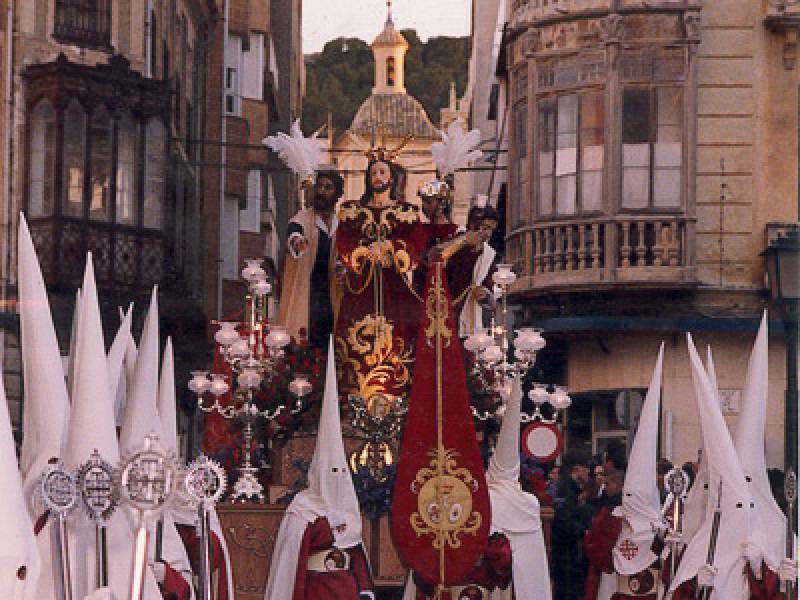 20.00: Procesión de la Pasión (Procession of Passion) from the Basílica de la Purísima.
20.00: Procesión de la Pasión (Procession of Passion) from the Basílica de la Purísima.
Route: Plaza de La Purísima, Calle España, Avenida Pablo Ruiz Picasso, Calle Francisco Castaño, Calle Esteban Díaz, Calle San Antonio, Calle San Francisco, Plaza de La Purísima to the Basílica de La Purísima.
17 Pasos:
1. Oración del Huerto
2. Jesús Prendido
3. Negación de San Pedro
4. Jesús Azotado a la Columna
5. Ecce-Homo
6. Nuestro Padre Jesús
7. Santa María Magdalena
8. San Juan Apóstol y Evangelista
9. Santa Faz y Verónica.
10. Santísimo Cristo de la Caída
11. Nuestro Padre Jesús de la Humildad
12. Santísimo Cristo de la Adoración de la Cruz (José Esteve y Bonet, 1800)
13. Santísimo Cristo de la Agonía
14. La Lanzada
15. Santísimo Cristo de la Buena Muerte
16. Nuestra Señora de las Angustias (Francisco Salzillo, 1793)
17. Nuestra Señora de la Esperanza
23.55: Procesión del Silencio (Procession of Silence) from the Iglesia del Hospitalico
Route: Calle Hospital, Calle Jabonerías, Calle Corredera, Plaza Mayor, Calle Epifanio Ibáñez, Calle Niño Jesús, Calle Pintor Aguirre, Calle Juan Ortuño, Plaza de La Purísma, Calle España, Placeta Ortega, Calle Hospital to the Iglesia del Hospitalico.
Paso:
Santísimo Cristo de la Paz (José Justo Villalva, 1950)
Friday April 7, Viernes Santo (Good Friday)
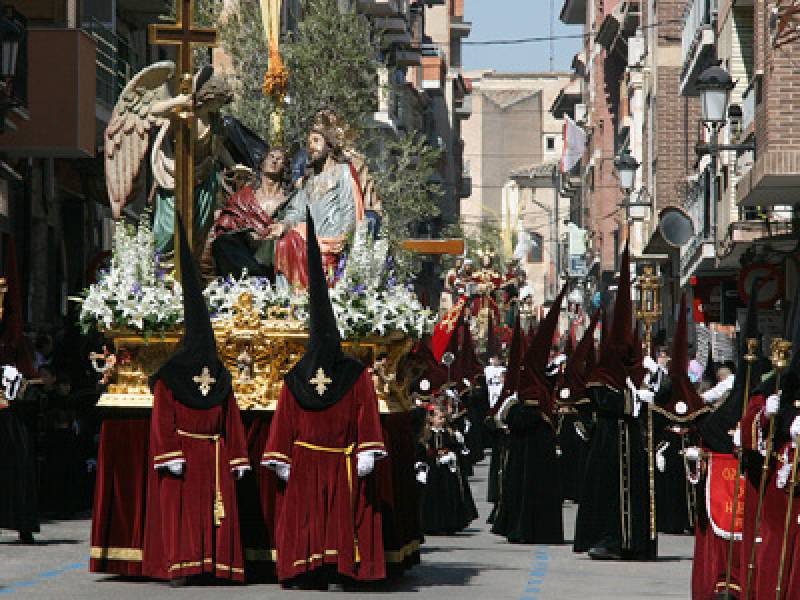 On Good Friday there are processions in both the morning and evening.
On Good Friday there are processions in both the morning and evening.
9.00: Procesión del Calvario (Procession of Calvary) from the Basílica de la Purísima
Route: Plaza de la Purísima, Calle Juan Ortuño, Calle Arco del Niño, Calle Niño Jesús, Calle Quevedo, Calle Epifanio Ibáñez, Plaza Mayor, Calle Concejal Sebastían Pérez.
At 11.00, and the meeting takes place between the figures of Jesus and the Virgen de la Esperanza before the procession continues on the following route: Calle Corredera, Calle Cruz de Piedra, Calle San Isidro, Calle España, Plaza de La Purísima to the Basílica de La Purísima.
17 Pasos:
1. Oración del Huerto
2. Jesús Prendido
3. Negación de San Pedro
4. Jesús Azotado a la Columna
5. Ecce-Homo
6. Ntro. Padre Jesús
7. Sta. María Magdalena
8. San Juan Apóstol y Evangelista
9. Sta. Faz y Verónica
10. Santísimo Cristo de la Caída
11. Ntro. Padre Jesús de la Humildad
12. Santísimo Cristo de la Adoración de la Cruz
13. Santísimo Cristo de la Agonía
14. La Lanzada
15. Santísimo Cristo de la Buena Muerte
16. Nuestra Señora de las Angustias
17. Nuestra Señora de la Esperanza
20.00: Procesión del Santo Entierro (the burial of Christ), departing from the Basílica de La Purísima.
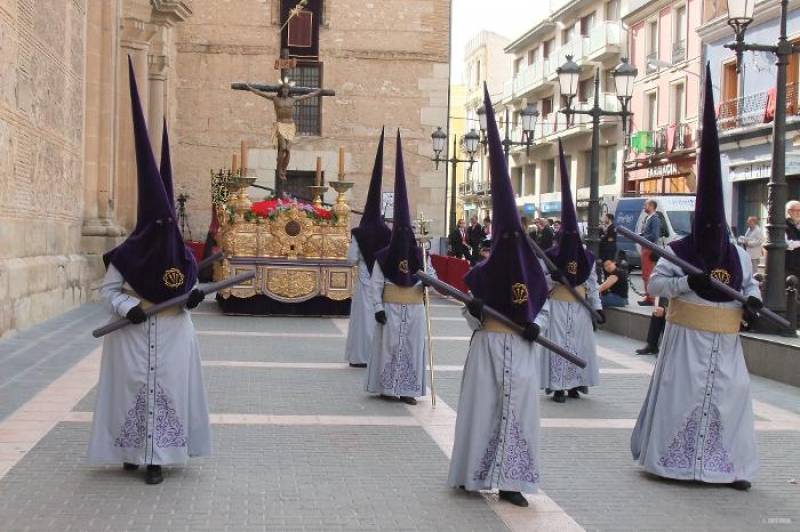 Route: Plaza de la Purísma, Calle España, Calle San Isidro, Calle Cruz de Piedra, Calle Hospital, Calle Niño Jesús, Calle Pintor Aguirre, Calle Juan Ortuño, Plaza de la Purísima to the Basílica de La Purísima.
Route: Plaza de la Purísma, Calle España, Calle San Isidro, Calle Cruz de Piedra, Calle Hospital, Calle Niño Jesús, Calle Pintor Aguirre, Calle Juan Ortuño, Plaza de la Purísima to the Basílica de La Purísima.
15 Pasos:
1. Ángel de la Pasión
2. Sta. María de Cleofás
3. Sta. Mujer Verónica
4. La Lanzada
5. Cristo de la Buena Muerte
6. Sagrado Descendimiento de Cristo
7. Nuestra Señora de las Angustias
8. Traslado al Sepulcro
9. Nuestra Señora de los Dolores al Pie de la Cruz.
10. Santísima y Vera Cruz.
11. San Pedro
12. Santa María Magdalena
13. San Juan Apostol y Evangelista
14. Santísimo Cristo Yacente
15. Nuestra Señora de los Dolores y Soledad
23.55: Procesión de la Soledad. The Cofradías and the figures of Santa María Magdalena, San Juan, Santísimo Cristo Yacente and Nuestra Sra de los Dolores y Soledad go to the Iglesia de San Francisco to carry out the act of “the burial of Christ” via the following route: Plaza de España, Calle San Francisco and Parque de la Constitución.
This is known as the Procesión de la Soledad, and takes place on the following route: Parque de la Constitución, Calle San Francisco, Plaza de España, Calle Martínez Corbalán, Calle Hospital to the Iglesia del Hospitalico.
3 Pasos:
1. Sta. María Magdalena
2. San Juan Apostol y Evangelista
3. Nuestra Sra de los Dolores y Soledad
Sunday April 9, Domingo de Resurrección (Easter Sunday)
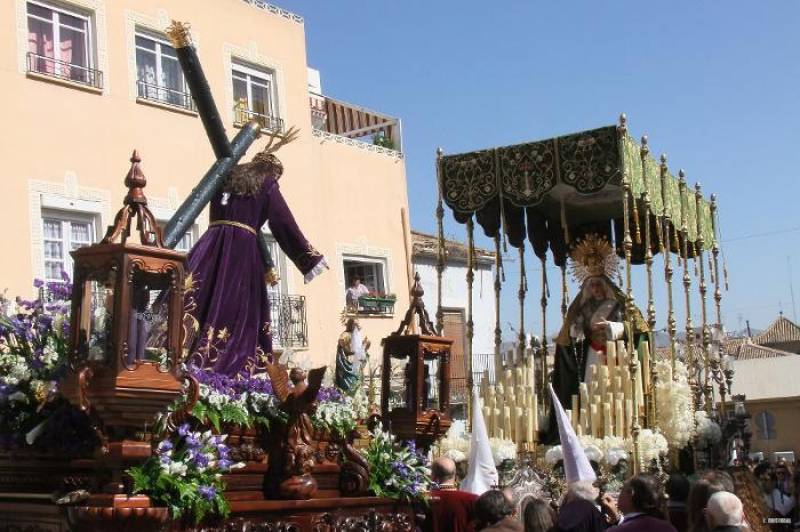 9.00: Procesión del Resucitado (Procession of the Resurrection) from the Basílica de la Purísima
9.00: Procesión del Resucitado (Procession of the Resurrection) from the Basílica de la Purísima
Route: Plaza de la Purísima, Calle Martínez Corbalán, Calle Niño Jesús, Calle Juana Valera, Calle Epifanio Ibáñez, Plaza Mayor, Calle Concejal Sebastián Pérez.
11 Pasos:
1. Cruz Triunfante
2. Santa María Salomé
3. Santa María Magdalena
4. Santa María de Cleofás
5. San Miguel
6. San Pedro
7. San Juan Apostol y Evangelista
8. Santiago
9. Aparición de Jesús a Santa María Magdalena
10. Aparición de Jesús a Santo Tomás
11. Santa María de la Alegría
10.30: Iglesia de San Francisco: the figure of Jesus resurrected takes the following route: Parque de la Constitución, Calle San Francisco, Calle Martínez Corbalán, Calle Hospital, Calle Maestro Polo, Calle Corredera, Plaza Mayor, Calle Concejal Sebastián Pérez.
11.00: Plaza Concejal Sebastián Pérez. The meeting between the sculptures of Jesus resurrected and Mary (Santa María de la Alegría) takes place, meeting marked with a huge firecracker being set off, along with what’s known as the "suelta del diablo" literally, letting the devil loose. Following this, they join together in procession and conclude the following route: Calle Corredera, Calle Cruz de Piedra, Calle San Isidro, Calle España, Plaza de La Purísima and back to the Basílica de La Purísima.
14:00. The “Caracol” in the Parque de la Constitución. (The time of this can vary depending on the conclusion of the resurrection procession).
The cofradía of San Juan and the cofradía of Ecce-Homo and the Resurrección form up and parade with their respective bands to the Parque de La Constitución, where they perform a typical "Caracol".
Click for further information about the municipality of Yecla.
staff.inc.ali



Hello, and thank you for choosing CamposolToday.com to publicise your organisation’s info or event.
Camposol Today is a website set up by Murcia Today specifically for residents of the urbanisation in Southwest Murcia, providing news and information on what’s happening in the local area, which is the largest English-speaking expat area in the Region of Murcia.
When submitting text to be included on Camposol Today, please abide by the following guidelines so we can upload your article as swiftly as possible:
Send an email to editor@camposoltoday.com or contact@murciatoday.com
Attach the information in a Word Document or Google Doc
Include all relevant points, including:
Who is the organisation running the event?
Where is it happening?
When?
How much does it cost?
Is it necessary to book beforehand, or can people just show up on the day?
…but try not to exceed 300 words
Also attach a photo to illustrate your article, no more than 100kb

